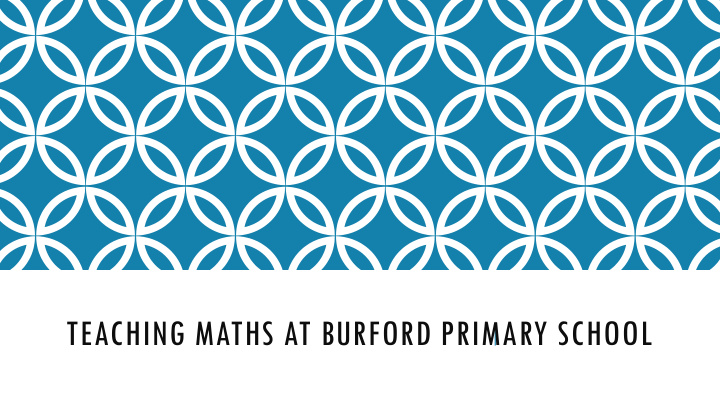



TEACHING MATHS AT BURFORD PRIMARY SCHOOL
AIMS OF THIS SESSION To gain an overview of how we teach maths throughout the school To share how we meet the expectations of the new maths curriculum To better understand the progression in written calculations throughout the school To experience some activities using our maths resources
CREATING A POSITIVE ETHOS IN MATHS The role of the Maths leader Changing children’s (and adults!) perceptions of maths Building on children’s interests and making learning purposeful Creating opportunities to explore maths through practical activities Teaching children that it’s OK to make mistakes – we can learn from them Developing enquiry, reasoning and problem solving skills Providing children with a range of strategies to solve problems Providing challenge for all – inclusion is key
LEARNING OBJECTIVES AND SUCCESS CRITERIA Learning objectives are shared with the children at the beginning of EVERY lesson so that they understand what they are learning E.g. LO: I can add two 2 digit numbers Success criteria are the steps that help the children to meet their learning objective E.g Partition the number into tens and units Add the tens Add the units Add your answers together
LO: ROUND TWO-DIGIT NUMBERS TO THE NEAREST 10 SUCCESS CRITERIA: Look at the digit in the units column – if it is 5 or more then round the number up, 4 or less round the number down. Make the tens number 1 ten bigger when rounding a number up Keep the tens number the same when rounding a number down Check your answer has 0 in the units column (ends in 0)
THE NEW MATHS CURRICULUM…IN A NUTSHELL The National Curriculum for mathematics aims to ensure that all pupils: - Become fluent in the fundamentals of mathematics. - Reason mathematically by following a line of enquiry, conjecturing relationships and generalisations, and developing an argument … using mathematical language . - Can solve problems by applying their mathematics to a variety of routine and non- routine problems with increasing sophistication.
WRITTEN METHODS IN CALCULATION To help support and develop your child’s mathematical understanding, each operation is taught according to a clear progression of stages. Generally, children begin by learning how written methods can be used to support mental calculations. They then move on to learn how to carry out and present calculations as jottings (informally) and then progress to use vertical methods, first in an expanded form and then in compact form.
ADDITION
STAGE 1
STAGE 2
STAGE 3
STAGE 4
STAGE 5
STAGE 6
SUBTRACTION
STAGE 1
STAGE 2
STAGE 3
STAGE 4
STAGE 5
MULTIPLICATION
STAGE 1
STAGE 2
STAGE 2
STAGE 3
STAGE 3
STAGE 4
STAGE 5
DIVISION
STAGE 1
STAGE 2
STAGE 3
STAGE 4
STAGE 5
Battleships Noughts and crosses MATHS AT HOME Paying at the shop Baking Finding 3D shapes Counting games Dot to dot Skittles Number songs in the car Darts Adding up a bill or receipt Board games Snakes and ladders Card games Making shape pictures Dominoes Measuring lengths of objects Telling the time Reading coordinates on treasure maps Small world play Top trumps
THE REST OF THIS MORNING… Spend some time in the hall. Children from year 1 to 6 are here to show you the progression in multiplication. 9:50 – 10:15 Visit the classrooms and see maths in action. 10:15 – 10:45 Feel free to stay and ask Mrs Beaney any questions that you may have.
Recommend
More recommend